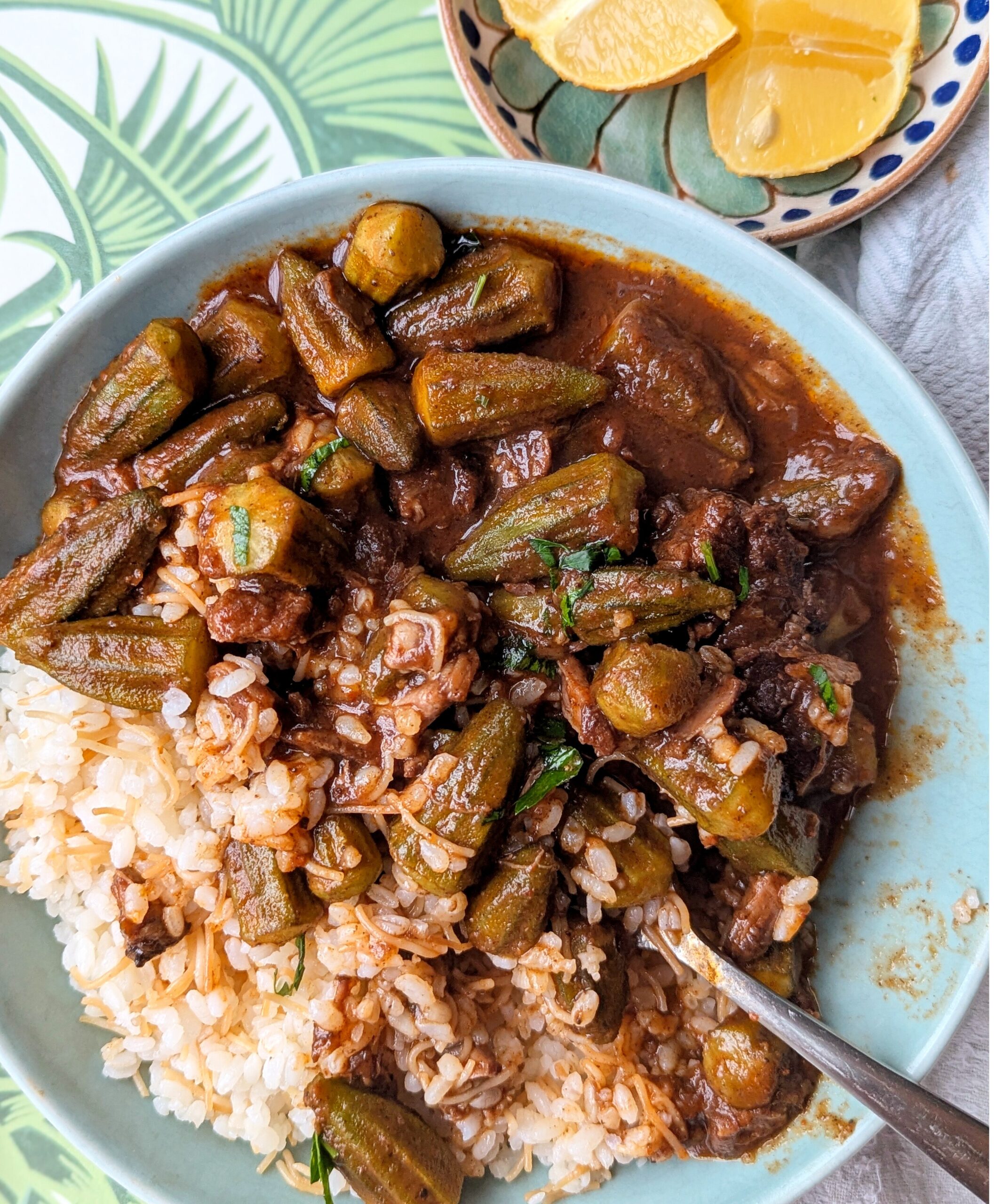
Bamya – Okra and meat stewfeatured
This rich and comforting bamya stew consists of okra cooked with tender pieces of lamb, in a luscious tomato sauce laced with garlic and cilantro.
This recipe is a family favorite. I always make a large pot for dinner with lots left over for the next day.
Bamya is widely considered to taste even better the next day, so it is a great make-ahead meal or for meal prep.
Jump to RecipeWhat is bamya?
Bamya is the Arabic term for okra, and also refers to this stew, which is made with meat and a rich tomato sauce.
A staple food in Egypt and across the region, this red sauce version is ubiquitous around the Middle East. However, in Egypt bamya is made several other ways as well.
Commonly served as a complete family meal that consists of protein, veggies and served over rice, bamya is curiously a polarizing dish.
A beloved favorite for many (like me and my kids!), it is at time maligned by those who dislike the texture of okra, which has natural mucilaginous properties and can release a slimy texture.
To me, the thick luscious texture –aka slime– is the best part of the dish!
But if you’re not quite on board with that, fret not, I will show you how to make this dish with or without the slime.
So, let’s go!
Components of this bamya stew
Bamya / Okra
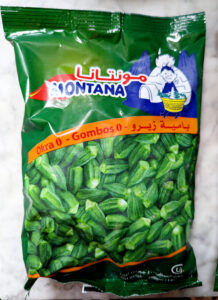
The type of okra I use here is baby okra, which is the most tender. I buy it frozen, thus it can be found year-round and kept in my freezer for any bamya cravings. Frozen okra can be easily found in any Middle Eastern grocery store. Look for the ‘Okra 0’ or ‘Okra zero’- indicating it is the smallest size okra.
If you want to use fresh, look for young, small okra. Whatever size you find, trim and slice it into rings. Larger okra will take longer to cook than smaller, but any type can be used based on availability.
Meat of choice
This dish is typically cooked with bone-in lamb, but can be made with beef. I actually love to make it with goat as well, similar to how I do here in my Egyptian green bean (fasolia) recipe.
While the bones add a lot of flavor to the stew, you can use boneless. I would reduce the weight of meat in that case. Cooking time with boneless meat will generally be quicker as well.
This dish can also be made by omitting the meat entirely for a vegetarian option. Swap ghee for oil in the process to make a vegan stew.
Tomato
Here, I’ve used only tomato paste in the sauce. It adds tons of depth and richness to the stew. Plus, I love making bamya in the winter, when fresh tomatoes are not very tasty where I live.
However, you can also make this with pureed fresh tomatoes or tomato sauce if you prefer, or make the recipe as is with the addition of some chopped fresh tomatoes.
Tasha
Tasha is a common element that is added to Egyptian stews or soups near the end of cooking. It consists of minced or mashed garlic fried in ghee or oil then added to the pot.
It usually also contains a spice, like the garlic and coriander tasha used in my Egyptian molokhia recipe.
In this bamya recipe, the tasha is made with fried garlic and minced cilantro leaves, and adds a beautiful fragrant and fresh element to the stew.
Making bamya
Cooking the meat
First, you will start by cooking your meat and making the base stock of your bamya.
Season your meat of choice liberally with salt and pepper, then sear on all sides in hot ghee or a neutral oil with a high smoke-point.
As always when searing meat, make sure not to crowd your pot. Work in batches as necessary so you get a good sear on your meat, instead of steaming it in a crowded pot. The carmelization of the meat will lend tons of flavor to the bamya, so don’t rush this step.
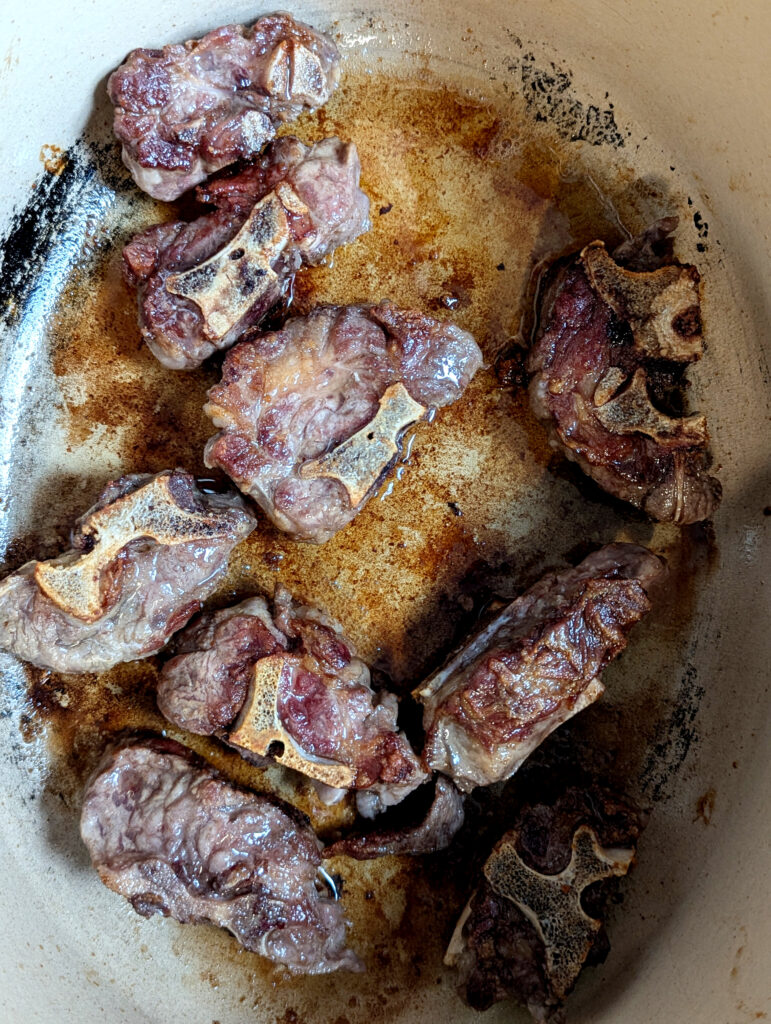
Transfer seared meat to a plate and set aside.
Lower the heat and add onions and aromatics, return the meat to the pot and mix.
Add water. Bring to a boil, then lower to a simmer and cover.
Cook until the meat is fork tender, and, if it has bones, it comes off them easily.
The cooking time on your meat will vary greatly depending on the cut you’ve chosen. Here I used bone-in lamb stew and it took about an hour and a half to get to desired tenderness.
Adding bamya and tomato
Once your meat is tender, you will add tomato paste and okra to the savory, flavorful base you’ve created.
Stir well to incorporate, and cook until okra is tender, about 20-30 minutes.
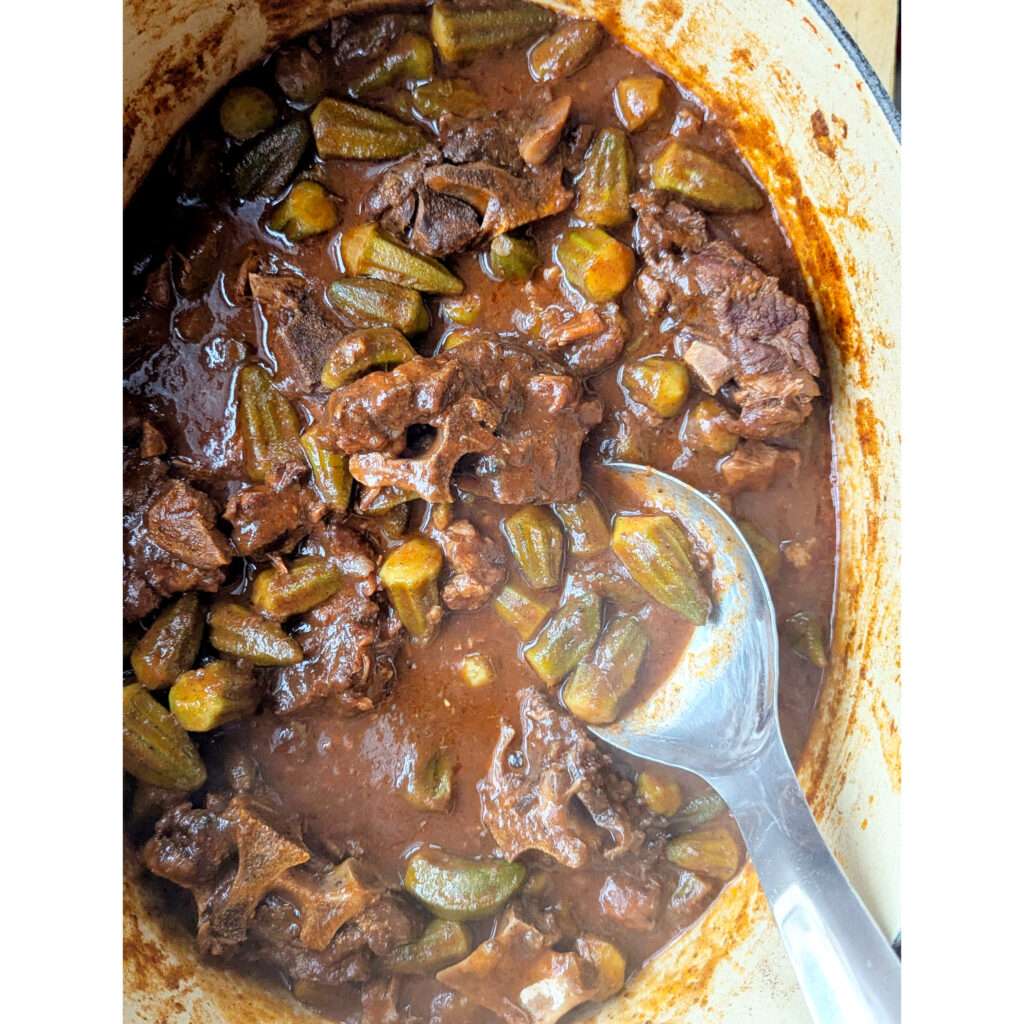
Making and adding your tasha
Now you will add the tasha to add extra flavor.
Fry up your garlic and cilantro and add to the pot.
Add lemon juice, taste, and adjust salt.
At this point, you face an existential question…
To slime or not to slime?
Some people prefer their bamya to be slimy and viscous, and others scorn the slime.
If you do not want slimy bamya, make sure to stir it gently at all stages of cooking, so as to keep intact.
If you, like me, do embrace the luscious texture of a slimy stew, make sure to break up your bamya pieces at this stage. They will release mucilaginous proteins that will cause the stew to have a thick and luscious texture.
If you want a little bit of sliminess, break apart a few. If you want more, break apart more!
Serving bamya
I love to serve this bamya stew over Egyptian rice with vermicelli- roz bil shareya.
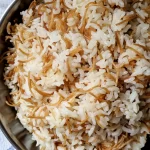
You can also serve it over plain white rice, or with pita bread for scooping up with your hands.
Serve with lemon wedges to squeeze over for added freshness, and some shatta if you like heat. Try my herby green shatta recipe here.
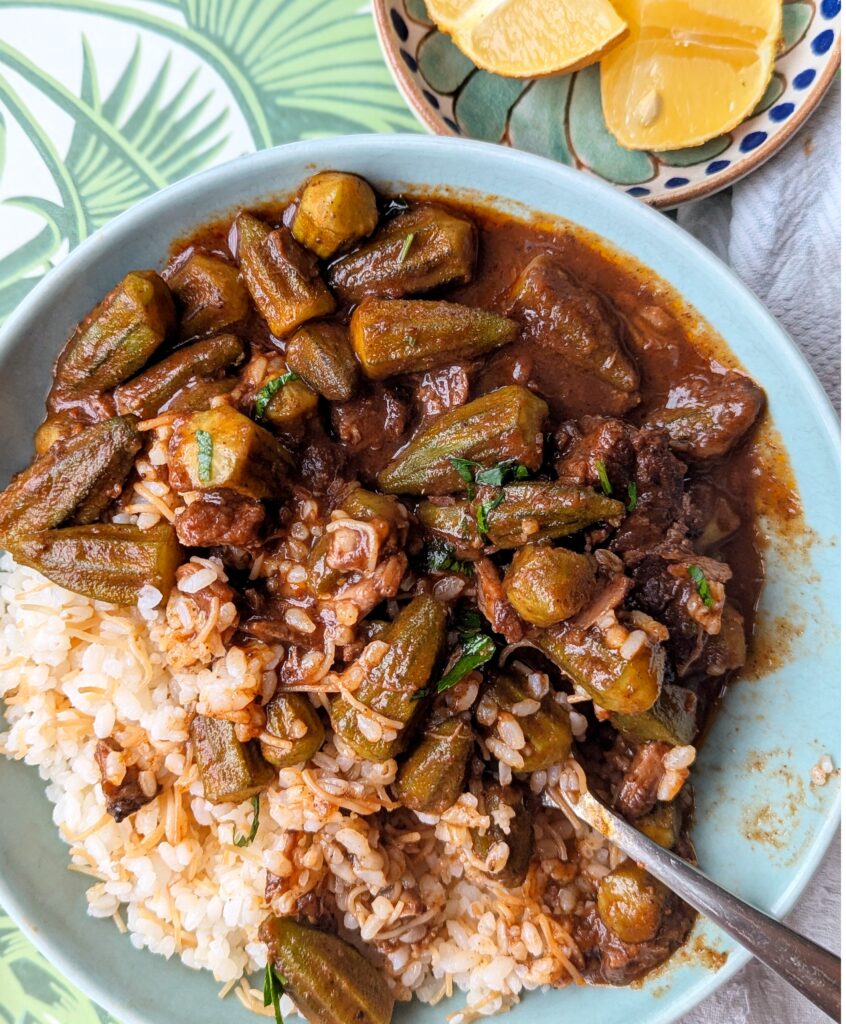
Bel hana wel shifa! Enjoy!
Bamya – Okra and meat stew
Equipment
- heavy bottom stewing pot eg enameled cast iron
Ingredients
For the stew base
- 2 lbs bone-in lamb stew meat can substitute with beef or goat, if using boneless meat, you can reduce the amount to 1-1.5 lbs
- kosher salt to taste
- 1.5 TBS ghee or neutral oil
- 1 medium onion, yellow or white chopped
- 1 bay leaf
- 2 tsp baharat / Lebanese 7 spice substitute 1 tsp allspice, 1/2 tsp coriander, 1/2 tsp cardamom
- 1/5 tsp cinnamon
- 5 cups water
Adding the bamya
- 2 packages frozen baby okra ‘zero’ size 28oz total
- 5 TBS tomato paste
- 1 lemon
For the Tasha
- 1.5 TBS ghee or neutral oil
- 5 cloves garlic finely minced or mashed
- 1 handful cilantro minced, leaves and soft stems
Instructions
For stew base
- Generously salt lamb pieces.
- In a heavy bottom large pot, heat ghee or oil.
- Sear lamb in hot ghee over high heat. Do not crowd the bottom of the pot. Work in batches as needed. Sear until browned all over. Transfer to a plate and set aside.
- Lower heat to medium. Add chopped onions and saute until softened, about 5 minutes.
- Add meat back to pot.
- Add spices and bay leaf. Stir to combine well with meat and onions. Stir continuously over heat until spices become fragrant.
- Add water, turn up heat to bring to boil, then lower to a simmer and cover. Cook until meat is fully tender, and if it has bones, comes off them easily.
Adding okra
- Add tomato paste to the pot, stir in thoroughly.
- Add frozen okra and stir gently to incorporate.
- Increase heat and bring to a boil again. Then reduce to simmer and cover. Cook until okra is tender, about 25 minutes.
Adding the tasha
- Heat ghee or oil in small frying pan over medium-high heat.
- Add garlic and cilantro and fry, stirring continuously until fragrant and the garlic is golden.
- Add to pot and stir to incorporate. If you do not want slimy okra, stir gently to keep okra intact. If you DO like slimy okra (like me!) use your spatula to break several pieces to release their mucilaginous proteins. The more you break, the slimier your stew will be.
- Now, add the juice of 1 lemon.
- Taste, adjust salt to your liking.
- Cover and allow to cook 5-10 minutes more.


